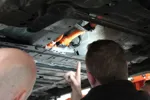Volkswagen is rolling out the use of hand-held tablet devices and video in dealerships in a bid to transform customers’ aftersales experience.
The manufacturer’s Aftersales Digital Reception (ADR) initiative will be introduced to Volkswagen’s 227 retail network throughout 2016 in a bid to introduce a new, more welcoming approach which keeps service customers informed during the process of servicing, maintenance and repair services.
Over 800 service advisors are undergoing detailed training online and at the Volkswagen National Learning Centre in Milton Keynes as part of the roll-out.
Kevin Rendell, Volkswagen UK’s head of service and parts operations, said: “The Aftersales Digital Reception initiative has been many months in the making and is, we believe, a revolutionary approach to Volkswagen servicing and aftersales customer care.
“Advisors consulting with customers, technicians demonstrating what work needs to be done via video and simple online explanations showing why work has to be carried out all combine to make the service process much less intimidating.
“The ADR initiative brings a revolutionary 21st Century retailing approach into what has, hitherto, sometimes felt like a process that has changed only slowly for decades.”
The ADR process has been created to give routine service customers a much clearer picture of what is happening to their car.
A service advisor will greet Volkswagen customers with an electronic tablet-based arrivals form and inspect their car – taking photographs of its condition if required – and talk them through the selected service/maintenance process.
Customers meet their advisor in the new, informal, service reception that does away with formal desks and desktop computers.
Volkswagen said that the outline of work is discussed and the customer either opts to wait for it to be carried out, or takes advantage of a pre-booked lift, or courtesy car to get on with their day.
As the car undergoes its 34-point visual check, carried out by a trained Volkswagen Service Technician, a video is created showing what work has been identified.
In the brief film the technician points out risks such as worn brake pads or tyres, and allows the customer to see for themselves any maintenance work required.
The video can then be sent straight to the customer’s computer, or smartphone, for them to view and make a decision on before any work begins.
Other routine maintenance tasks, such as cambelt changes, can be discussed with the service advisor too and, if required, explained via a library of simple online animations created by ‘Vehicle Visuals’ to help “demystify modern servicing tasks”, Volkswagen said.
These short ‘explainer’ videos work alongside a detailed website which includes all manner of maintenance information and explanations.


















STUART BENNETT - 04/05/2016 17:09
All because the consumer doesn't trust the dealer!